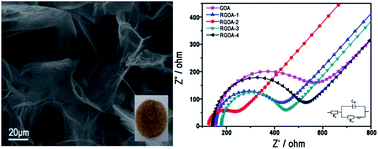Fundamental electrochemistry of three-dimensional graphene aerogels
Abstract
3D-architectured graphene is an emerging electrode material because of its ultra-low mass density and hierarchically connective pore-structure, which can provide a large accessible surface area and also enhance mass and electron transport. However, few reports are concerned with the fundamental electrochemical study of this fascinating material. In this work, we prepared reduced graphene oxide aerogel (RGOA) samples by thermal reduction of the original graphene oxide aerogel (GOA) at different temperatures and comparatively studied their structure and fundamental electrochemical performance. By using three representative inner- and outer-sphere redox probes, we found that RGOA, which was reduced at 250 °C outperforms its analogues by providing the lowest ΔEp as well as the highest k0. This is due to its abundant accessible active sites, which can effectively interface with electrolytes, facilitate electron transfer, and provide multiplexed and highly conductive pathways. In contrast to 2D-structured graphene, the electrochemical performance of 3D-architectured graphene is influenced by not only the amount of oxygen-containing groups and structural defects, but also by the macropores and surface roughness, which enhance hydrophilicity/hydrophobicity. The as-constructed RGOA-based sensor shows good sensitivity and selectivity for the detection of dopamine. This study adds a new dimension to the electrochemical performance and applications of 3D-architectured graphene.

- This article is part of the themed collection: Nanoscience and nanotechnology in electrochemistry

 Please wait while we load your content...
Please wait while we load your content...